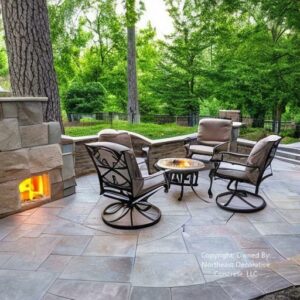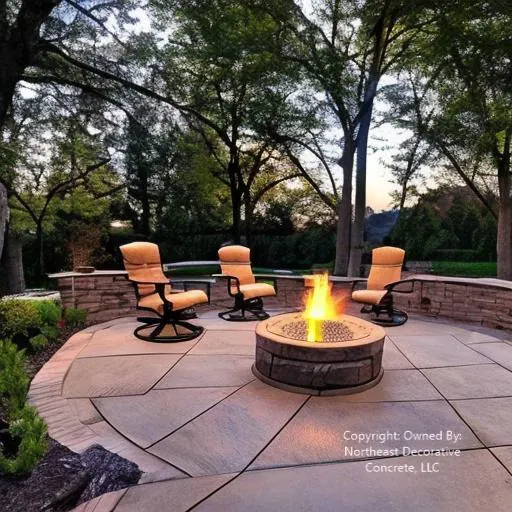
Learn more about the differences between rolling or spraying stamped concrete sealer. Find out which is the most effective method for sealing your colored concrete surface.
Is It Better To Roll Or Spray Stamped Concrete Sealer?
When choosing between rolling or spraying stamped concrete sealer, it all depends on the size of the surface. A sprayer is more efficient and faster for large floors, such as commercial floors. However, sprayers can be expensive, so renting may be an option. For small surfaces, such as epoxy garages or any other exterior patio or pool deck surface, a paint roller or any other type of roller will do the job and is cheaper than spraying.
The type of sealant also affects the choice of application tool. Penetrating sealants can be applied with either a pump-up sprayer, paint roller, or brush. Acrylic sealants or epoxy floor coatings are best applied with a 1/4′ or 3/8′ nap roller designed for epoxies and urethanes.
It is essential to clean the concrete before applying the recoat to stamped concrete. A light degreaser followed by lots of water is suggested for interior concrete, while a diluted acid solution with power washing is suggested for exterior surfaces. The concrete must also be completely dry to avoid fogging and causing problems. It is also vital to prevent overapplying sealants, which is more common and problematic than underapplying.
Understanding the Basics of Decorative Concrete Sealants
Textured concrete clear coats are designed to protect concrete from the elements and wear and tear. Sealants do this by forming a thin, protective layer over the surface of the concrete. This layer helps to repel water while protecting the concrete from UV damage and staining.
Most sealants come in two forms: liquid or aerosol. Liquid sealers are usually applied with a roller or brush, while aerosol sealants are sprayed on. Both have their advantages and disadvantages, and the right choice will depend on the size and complexity of your patterned concrete project.

Advantages of Rolling Sealer
Rolling textured concrete top clear coats is the traditional method to apply the sealer to colored concrete. It involves using a roller to spread the sealant evenly over the concrete surface. This method is best for large substantial areas, as it ensures an even, consistent coat of sealant. Selecting the appropriate size nap for sealing concrete is crucial to achieving an optimal finish. A roller with a thicker nap can hold more sealant and is beneficial for textured surfaces, while a thinner nap is suitable for smoother finishes.
One of the main advantages of rolling concrete clear coats is its cost-effectiveness. Rollers and brushes are relatively inexpensive, and a single gallon of seal can cover a large area. Additionally, it is easy to control the amount of sealant being applied, and it is simple to clean up any spills or drips.
Disadvantages of Rolling Sealer
One of the main drawbacks of rolling colored concrete clear coats is that it can take a lot of work to achieve a uniform, even coat of sealer. This is because rolling requires a steady hand, and getting into corners and around edges can be difficult. Additionally, it can be time-consuming, especially on larger projects.

Advantages of Spraying Sealer
Spraying patterned concrete seal is a much faster and simpler method than rolling, and it is often used for smaller projects. It involves using an aerosol can to apply a light mist of sealant over the concrete surface.
One of the main advantages of spraying textured concrete top clear coats is that it is much easier to achieve a uniform, even coat of sealant. It is also much faster and requires less effort than rolling, making it ideal for smaller projects. Additionally, spraying is much less messy, as there is no need to clean up any spills or drips.
Disadvantages of Spraying Sealer
The main disadvantage of spraying patterned concrete top clear coats is its cost. Aerosol cans are much more expensive than liquid sealants and usually only cover a small area. Additionally, it can be challenging to control the amount of sealant being applied, and it can be easy to use too much which could bubble or too little.
FAQs:
Q: How Often Should I Seal My Concrete Patterned Surface?
A: Applying concrete sealer to your colored concrete every three to five years is recommended.
Q: What Type of Sealer Should I Use?
A: Using a concrete clear coat designed explicitly for patterned concrete is best. Also, it is best to use a water-based sealer that is a acrylic seal for interior applications. However, for Exterior surfaces, we recommend a solvent-based penetrating sealer. The reasons are that water-based has low VOC (volatile organic compounds). Therefore, they release fewer carbon-based compounds into the air, making them a more environmentally friendly option. vs. solvent-based, usually has 20 to 30 percent solids and a high VOC for exterior outdoor surfaces.
Q: Can I Apply Sealer To Wet Concrete?
A: Applying sealants to wet concrete is not recommended, as it may not adhere correctly.
Q: What Is The Best Way To Apply Sealer To Colored Concrete Surfaces?
A: The best way to apply a solvent-based sealer to decorative concrete is to use a roller. Start by applying the sealant to the perimeter of the concrete, and then work your way inward. Use a roller with a nap of 3/4 inch or more for best results. Apply at least two coats for maximum protection. Allow the sealant to dry completely between coats before applying a second coat.
Q: Can You Roll Sealer On Concrete Sealing Stamped Finishes?
A: Yes, you can roll the acrylic sealer on colored concrete. Just make sure you do not over apply the sealer. Follow the manufacturers recommendations. It is essential to use a sealant designed explicitly for patterned concrete, as it will provide the best protection against wear and tear and UV rays.
Q: What Type Of Sealer Is Best For Concrete Stamped Finishes?
A: The best seal for patterned concrete is an acrylic-based sealant. This type of sealant offers superior protection against stains, UV rays, and moisture while providing a glossy finish that enhances the beauty of the colored concrete.
Q: Should I Spray Or Back Roll Paver Sealer?
A: It depends on the paver sealant you’re using and the size of the area you’re covering. Generally, use a sprayer application is best for large, even surfaces, while rolling is better for smaller, more uneven surfaces. If you need more clarification, it’s best to consult the manufacturer’s instructions.
Conclusion
Deciding whether to roll or spray concrete sealer application to colored textured concrete top clear coats is an important decision. Rolling is the traditional method and is best for smaller types of concrete projects, as it is cost-effective and ensures an even, consistent coat of sealant. Spraying is a faster and simpler method, and achieving a uniform, even coat of sealant is much easier. However, it can be expensive, and applying too much excess sealer or too little is straightforward. Ultimately, the right choice will depend on your project’s size and budget.
Our Locations:
Nashua, NH
North Hampton, NH
Concord, NH

